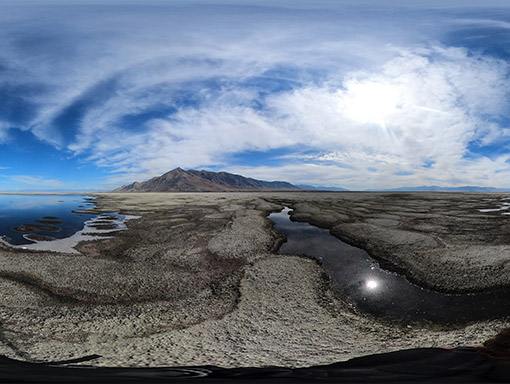Close your eyes and picture this landscape: A lake so salty, it can support almost no life; where the water itself takes on a delicate, dreamlike pink hue; surrounded by an endless expanse of barren wasteland, with salt flats stretching as far as the eye can see, sand dunes rising and falling in the distance, and rocky outcroppings jutting out from the earth like jagged teeth. It may sound like something from the imagination of the world of classic Sci-Fi novels such as Dune, but this otherworldly scene is, in fact, the reality of the Great Salt Lake.
Spanning over 950 square miles in northern Utah, the Great Salt Lake is the largest saltwater lake in the Western Hemisphere, the largest lake west of the Mississippi River, and the 8th largest terminal lake in the world. To put its size into perspective, it’s approximately the same area as Yosemite National Park, and back in the 1980’s, at its historic height, it was almost three times that.
Don’t let its name fool you – it’s far from just a big pond full of saltwater. This lake is a thriving ecosystem, home to a variety of unique species, and a beloved spot for locals and tourists alike. From its fascinating geology to its abundant and unusual wildlife, there’s so much to discover about this incredible lake. With our guide, you can take a virtual tour of the lake, learning about its history and ecology, and the ongoing efforts to preserve this natural wonder.
Geology and geography overview
The Great Salt Lake Basin is a true marvel of nature. It’s a remnant of the ancient Lake Bonneville, a massive body of water that once sprawled across an area roughly the size of modern-day Michigan, making it one of the largest lakes in the history of North America. But during the last Ice Age, approximately 10,000 years ago, melting glaciers carved out the basin, and in doing so, they created the perfect conditions for the Great Salt Lake to come into existence.
As the glaciers melted, they left behind an intricate network of streams and rivers that flowed into the basin, slowly filling it with water. However, with no outlet to the ocean, the water in the basin had no place to go but up, and it eventually began to evaporate. This process still continues to this day, and as the water evaporated, it left behind a high concentration of minerals, including salt, resulting in one of the saltiest bodies of water on Earth.
Today, the Great Salt Lake is approximately 75 miles long and 35 miles wide, boasting a maximum depth of 33 feet. Its shoreline spans over 1,000 miles, about as much as the distance between New York City and Florida, and it’s constantly in flux as water levels rise and fall. The lake is separated into two main bodies of water, the North Arm and the South Arm, connected by a narrow channel known as the Causeway.
However, the Great Salt Lake is more than just a vast expanse of saltwater – it’s a veritable wonderland of geological marvels. The lake is surrounded by a breathtakingly diverse array of terrain, from the shimmering, surreal salt flats that stretch as far as the eye can see, to the towering sand dunes that rise and fall in the distance, sculpted over millions of years by the relentless forces of wind and water.
The salt flats themselves are an otherworldly sight to behold, formed by the gradual evaporation of the lake’s waters over millennia. These vast expanses of glistening white, crunchy salt crystals create an eerie and mesmerizing atmosphere. Meanwhile, the sand dunes offer a stark contrast to the calm waters of the lake, their rippling curves and dramatic peaks carved into existence over countless eons by the raw power of the elements.
But that’s not all – the lake’s surroundings also boast rocky outcroppings and craggy cliffs, testament to the region’s rich geological history. All of these elements combine to create a landscape that is truly one-of-a-kind, a natural wonder that draws visitors from far and wide to marvel at its awe-inspiring beauty.
Wildlife and ecology
The Great Salt Lake isn’t just a unique geological wonder, it’s also a thriving ecosystem teeming with diverse wildlife. The lake and its surrounding wetlands provide crucial habitats for a wide range of species, making it an important destination for birdwatchers, anglers, and nature enthusiasts alike.
Among the lake’s most notable residents are the tens of thousands of migratory birds that use the lake as a resting stop during their long journeys. The lake’s shallow waters and brine shrimp make it a prime feeding ground for birds such as the American avocet, the Western grebe, and the Wilson’s phalarope. These birds are just some of the many species that can be spotted during the spring and fall migrations, making the lake a popular spot for birdwatchers from around the world.
But birds are not the only creatures that call the Great Salt Lake home. The lake is also home to a variety of fish species, including the Bonneville cutthroat trout, which is found only in the lake and its tributaries. Fishing for cutthroat trout is a popular activity among locals and visitors alike, with the trout’s rich, buttery flavor making it a prized catch.
On the lake’s shores, visitors may also spot a variety of land mammals, including pronghorn antelope, Bisons and coyotes. These animals are adapted to the harsh, arid conditions of the region and are an important part of the lake’s unique ecology.
History
For thousands of years, various indigenous tribes such as the Shoshone, Ute, and Paiute called this land home. They relied on the lake for food, medicine, and cultural ceremonies. The Shoshone name for the lake, “Concentrated Bad Water,” reflects the high salinity levels that make the water undrinkable for humans. However, this did not stop the indigenous communities from utilizing the lake’s resources. In their folklore, the lake is said to be home to a powerful serpent spirit named Bear Lake Monster, who is said to dwell deep in the lake’s depths. These myths and legends add to the cultural and historical significance of the lake and serve as a reminder of the deep connection between humans and the natural world. Today, efforts are being made to recognize and honor the contributions of indigenous communities, including the use of traditional ecological knowledge in conservation efforts, and many indigenous activists are leading the fight for protecting the lake.
Challenges and conservation efforts
The Great Salt Lake Basin is not just a haven for wildlife, but also a hub of ecological activity, facing an array of challenges that threaten its very existence. The lake’s water levels are shrinking at an alarming rate, leading to increased salinity and pollution from agricultural runoff and human water diversion. Continued shrinkage could turn the lake into a bowl of toxic dust, catastrophically poisoning the air around Salt Lake City.
Hope is not lost – several organizations are leading the charge in conservation efforts to protect this natural wonder. The Great Salt Lake Institute, for example, is dedicated to monitoring water quality, restoring wetlands, and raising awareness about the lake’s significance as a habitat for birds, fish, and mammals alike. Projects such as wetland restoration can greatly help biodiversity, while preventing water diversion and ensuring proper treatment can help maintain the water levels high and the quality sufficient to support life.
Preserving the Great Salt Lake is not just a matter of preserving a natural landmark with a rich history; it’s a matter of preserving an entire ecosystem and the many lives that depend on it. With continued efforts and education, we can ensure that this veritable wonderland of geological marvels remains a breathtaking destination for generations to come.
Visiting the Great Salt Lake
If you’re itching for an adventure, look no further than the Great Salt Lake. This marvel of nature offers a plethora of exciting activities to satisfy even the most adventurous souls. Embark on a hike or bike ride along the lake’s pristine shoreline, where you’ll be greeted with stunning vistas at every turn. For the brave-hearted, take a refreshing dip in the buoyant waters or even go for a leisurely float.
But wait, there’s more! The lake’s geological wonders are a treasure trove for photography and art enthusiasts, with endless opportunities to capture the natural beauty of this unique landscape. And for those seeking a different kind of thrill, birdwatching and angling are popular pastimes in the area, with local lodges and hobbyist groups ready to provide the ultimate experience.
The icing on the cake? Your visit to the Great Salt Lake contributes to the ongoing conservation efforts to preserve this ecosystem for future generations. So, pack your bags, bring your camera, and get ready for an unforgettable journey into the heart of this natural wonder.
Conclusion
The Great Salt Lake is a true marvel of nature, a place where the forces of geology, ecology, and wildlife converge to create a truly unique ecosystem. From the shimmering salt flats to the thriving bird populations, the lake is a testament to the resilience and adaptability of the natural world. However, the challenges it faces are equally significant, and the ongoing conservation efforts are critical to ensure the lake’s survival for generations to come. By visiting and enjoying the many activities the lake has to offer, you can not only experience its beauty firsthand but also contribute to its protection. So if you’re looking for a one-of-a-kind destination that’s as fascinating as it is beautiful, be sure to put the Great Salt Lake on your list.


0 Comments